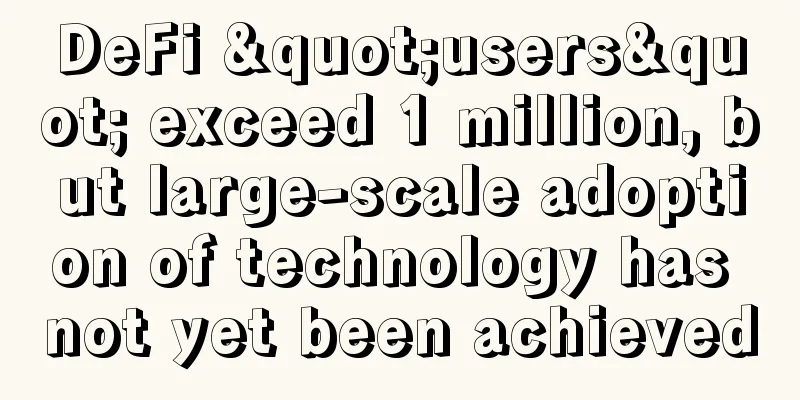DeFi "users" exceed 1 million, but large-scale adoption of technology has not yet been achieved

|
According to a report released on December 4 by crypto data website Dune Analytics, the number of participants with unique Ethereum addresses in the decentralized finance (DeFi) ecosystem has exceeded 1 million, more than tenfold compared to 91,000 on December 6, 2019. But despite the growth, some experts are reminding crypto users that it’s too early to consider DeFi mainstream adoption. In fact, in order for DeFi to truly break through, many of the new verticals’ backers may have to rethink their communication and outreach strategies. The Dune Analytics report aggregates the total number of addresses that have ever used popular DeFi protocols such as Uniswap, Compound, and Aave, and notes that they use the number of "unique addresses" as a proxy for the number of "users," meaning that the millionth address mark may not be as optimistic as it might seem at first glance. Many DeFi users typically deploy multiple addresses to protect their privacy when transacting on Ethereum's public network, and combining "addresses" with "users" may lead analysts to some questionable numbers. Brian Flynn, co-founder of Rabbithole, a startup that helps incentivize people to participate in DeFi, suggested that the number of actual participants is much smaller. “The reality is the number of unique users is only 10-15% of it. That’s the metric that really matters,” Flynn said. Finding ways to incentivize user participation in DeFi governance and infrastructure layer elements will lead to sustainable success in the long run. Patrick Rawson, co-founder of blockchain experimentation agency Curve Labs, said the current user experience in DeFi is targeted at a very specific demographic. “The people who use these mechanisms skew male, skew younger, skew more likely to want to make money, and skew more likely to be tech savvy,” Rawson said. “The user profile will ask for whatever will get them the most profit.” Rawson believes that if DeFi truly wants to “provide funding to users who don’t have funding” and reach the “last mile,” they may have to consider new outreach strategies that will better enable users to seek their desired outcomes. “Let’s look at another user’s profile. Older, from Sub-Saharan Africa, female, with a family, not technically savvy. Would this user want to extract profit at the expense of everything else? No, she’s probably more interested in her surroundings, and in the health and wellness of her family. [...] She wants DeFi that benefits her local community, not DeFi that maximizes profit at all costs.” To make this transition, DeFi will have to adapt to “localized institutional structures that reflect local values,” Rawson said. Flynn agreed with Rawson that focusing on profits above all else could be a limiting way to spread the DeFi gospel. The way current ecosystem participants discuss DeFi with friends and family will also play a big role in the journey towards the future: “We need to stop focusing on price and focus more on crypto networks and decentralization as a new way to build organizations.” |
<<: About Filecoin's four major implementations
>>: Grayscale, the giant whale, may be honey at this time and ***** at that time
Recommend
Walle Finance | WalleWalle 23rd Live Interview - Dialogue with Gate.io CPO Jiuer
Walli Finance invites you to witness the blockcha...
What kind of people like to gossip?
What kind of people like to gossip? In "Ma Y...
What does a crooked nose mean in physiognomy?
In physiognomy, the nose is the location of a per...
The Mastermind Behind $722 Million Bitcoin Ponzi Scheme BitClub Arrested in Indonesia
According to BlockBeats, on June 16, local author...
What kind of men are smart and capable, suitable for starting a business?
Not everyone is suitable for this great and diffi...
Why blockchain technology can rewrite the global financial landscape
Simon Johnson, a professor at the MIT Sloan Schoo...
The increase in the total network computing power has pushed the Bitcoin halving to be "earlier" than expected
Bitcoin, the cryptocurrency with the largest mark...
What are corns? Corns face analysis
What do corns look like? Analysis of corns in phy...
Shanghai Blockchain Hackathon Competition to be held in January 2016
It is reported that Wanxiang Blockchain Lab and D...
What is the fate of a woman with a high nose?
After all, a person's life is actually full o...
Is it true that people with sparse eyebrows are very lonely?
In this world, there are only a few people who ca...
Is it true that people with crooked noses are more likely to lose money?
Money is something that everyone pursues througho...
A woman's face that shows she will be poor all her life
A woman's face that shows she will be poor al...
With the halving imminent, can Bitcoin lead the market to a new high?
Previous Issue Review BTC: BTC is in an important...
Bitcoin is aiming for $19,000, but mining machines seem to be insufficient
Content Overview: 1. At the time of writing, acco...









